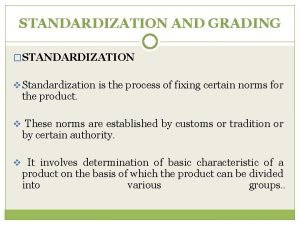DATA COMMUNICATION PRINCIPLES Standardization of Protocols Standardization of





- Slides: 5

DATA COMMUNICATION PRINCIPLES : Standardization of Protocols

Standardization of Protocols The developments in data communications seem to be headed towards the evolution of a global network requiring same protocols no matter where we are and with any computing equipment. However, the innovations and competition have a natural trend of obstructing this goal. Due to this reason, standardization process has seen more and more co-ordination internationally. In spite of all efforts of coordination, many organizations will have to continue their work in a particular direction due to their peculiar needs and circumstances. These needs and circumstances have something to do with factors such as: 1 - National economy of a country is booming and it decides to go ahead with the next generation of networks. An example of this situation is the Republic of Korea becoming a member of the Organization of the Economically Developed Countries (OECD) in the 90’s and spearheading for the latest developments in wireless networking.

Sometimes, special interest groups (SIG) of vendors and users would like to spur the process by making their own forums. This is a very common trend these days. An example is the ATM Forum that led the developments in ATM technology ahead of already established organizations. There are different needs of security and level of trading relations of all nations. For example, encryption algorithms, developed in one country may not always be available in some other countries. Then, there is a different infrastructure in every country. Some countries have optical fiber networks, other emphasize on wireless technologies. Sometimes, a nation lacking a certain infrastructure would like to bypass some technologies and go directly to a later stage. An example is in going wireless. Many nations find it difficult to build a wired network infrastructure, resulting in an emphasis on standardization in wireless communication. As a result of the above and perhaps other reasons, the standardization process will remain a heterogeneous one and the question of interoperability will always be there.

The following organizations are at the forefronts of providing standards on national and international levels. There are numerous national, vendors and consumers organizations that provide input and/or make their own standards. International Telecommunications Union (ITU) Internet Society International Organization for Standardization (ISO) European Telecommunications Standards Institute (ETSI) American National Standard Institute (ANSI) Institute of Electrical and Electronics Engineers (IEEE)

REFERENCES • Ahmad A. - Data Communication Principles. For Fixed and Wireless Networks • Cornelius T. Leondes - Database and Data Communication Network Systems, Three-Volume Set_. . -Academic Press









